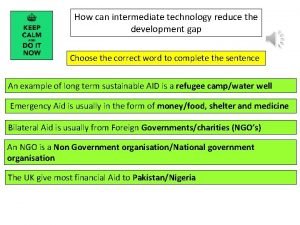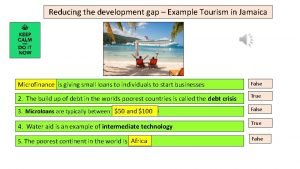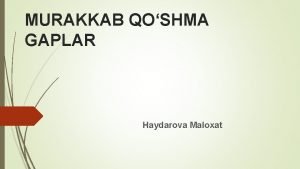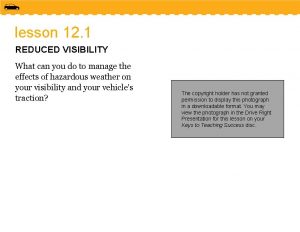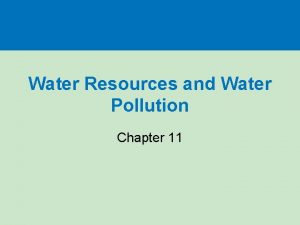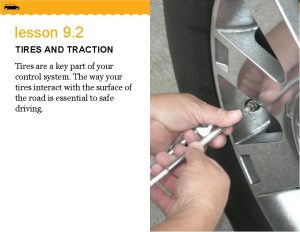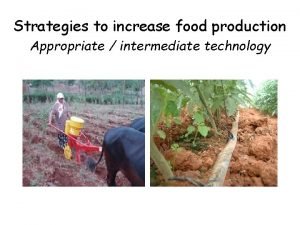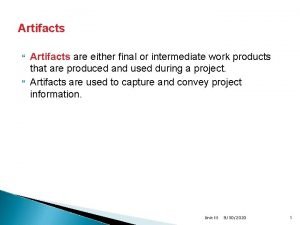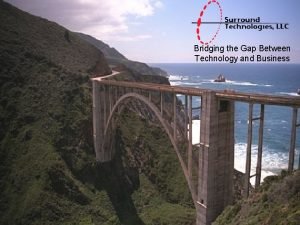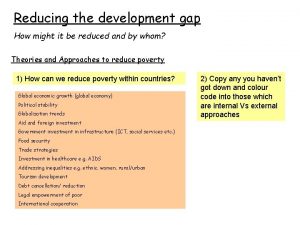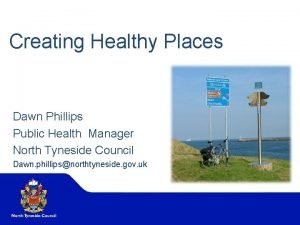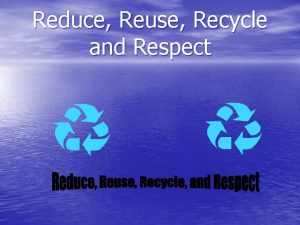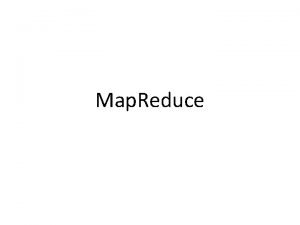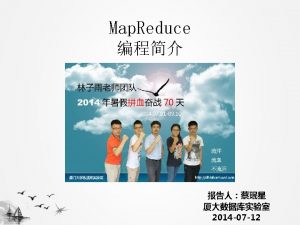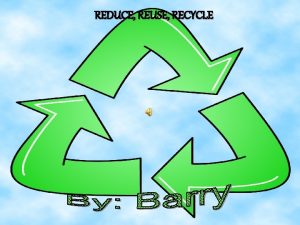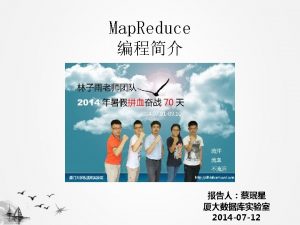How can intermediate technology reduce the development gap













- Slides: 13

How can intermediate technology reduce the development gap Choose the correct word to complete the sentence An example of long term sustainable AID is a refugee camp/water well Emergency Aid is usually in the form of money/food, shelter and medicine Bilateral Aid is usually from Foreign Governments/charities (NGO’s) An NGO is a Non Government organisation/National government organisation The UK give most financial Aid to Pakistan/Nigeria

How can intermediate technology reduce the development gap Choose the correct word to complete the sentence An example of long term sustainable AID is a refugee camp / water well Emergency Aid is usually in the form of money / food, shelter and medicine Bilateral Aid is usually from Foreign Governments / charities (NGO’s) An NGO charity is a Non Government organisation / National government organisation The UK give most financial Aid to Pakistan / Nigeria

To examine different types og intermediate technology Aid ‘so that I can explain how it improves peoples quality of life • I can identify different types of intermediate technology • • I can describe features of the water AID project • I can explain how they improve quality of life for people

Direct Vocabulary Instruction Intermediate technology A bicycle pump water well Definition: simple and practical tools, basic machines, and engineering systems that poor farmers and other rural people can construct from resources that are available locally to improve their well-being. Water AID is an NGO providing long term sustainable Aid to poor farmers in Kenya by providing intermediate technology water wells

Types of intermediate technology Intermediate technology usually takes the form of small scale projects that help with improvements in farming, water or health (basic needs) in local communities A simple water well in a village in Kenya 1. 2. 3. 4. A sand dam in Kenya Collects water in the rainy season for crop irrigation in the dry season A composting toilet. Waste decomposes and can then be used to fertilize crops What three things does intermediate technology most try to improve Explain how a simple water well helps people in Kenya Explain how a sand dam helps people in Kenya Explain how a composting toilet helps people in Kenya

Water Aid is a charity - NGO When a community gets clean water for the first time, it’s the start of something truly life changing. Right now, some of the world’s poorest and most marginalised people don’t have clean water to drink, decent toilets or hygiene. Without these basics, overcoming poverty is just a dream. 1. What three things are water Aid most concerned about improving for the worlds people? 2. Use the map and the internet to identify 5 countries in Africa where water Aid is working to improve lives

Sustainable Aid using Intermediate technology – Water Aid Describe the location of Kenya Include one general location fact Include 2 more specific location facts Kenya is located in East Africa The equator runs through Kenya East of Lake Victoria

The water problem in Kenya Water AID in Kenya - The crisis 51 million people live in Kenya. 17 million Kenyans still lack safe water and 32 million lack access to a toilet. (sanitation) Millions of people have to collect water from unsafe and unreliable supplies such as streams and watering holes. Water is polluted by animals and contains harmful bacteria and other pests. Diseases spread by lack of clean water and sanitation include cholera, diarrhoea, dysentery, hepatitis A, typhoid and polio. More than 3, 100 children die every year from preventable diarrhoeal diseases caused by unsafe water and poor sanitation. (lack of toilets) Collecting drinking water from a watering hole 1. 2. 3. 4. 5. 6. Water in Kenya is not distributed fairly. Priority is given to planned urban areas and wealthy rural communities that can pay for services, so those in slums and remote villages often go without. What percentage of people in Kenya lack a) safe water b) sanitation What is sanitation? Where does much of peoples drinking water come from? Why is collecting water from open watering holes bad for people? Why do over 3100 children die each year? Why is water in Kenya not distributed fairly?

Types of intermediate technology Three things intermediate technology most tries to improve are _______________ and ______ A simple water well helps people in Kenya because ____________________________ A sand dam helps people in Kenya because ________________________________ A composting toilet helps people in Kenya because _____________________________ Water Aid Three things water Aid is most concerned about improving for the worlds people are _______ , _______ and _______. 5 countries in Africa where water Aid is working to improve lives are _______________ _______________ Kenya is located in _________________________ The water problem in Kenya Percentage of people in Kenya lack a) safe water _____ % b) sanitation _____ % Sanitation is ___________________ Much of peoples drinking water comes from ______________________________ Collecting water from open watering holes is bad for people because _________________________________________ Over 3100 children die each year from ________ Water in Kenya not distributed fairly because ______________________________ A rope pump an example of intermediate technology because ________________________________________________ Two reasons why a rope pump improves quality of life are ________________________________________________ A composting toilet is _______________________________________ Two reasons why a composting toilet improves quality of life are ________________________________________________ Many villagers are not well educated about hygiene because ____________________________________________ They using pictures to educate people about the benefits of hygiene because ________________ Better hygiene improve people’s quality of life because __________________________

Intermediate Technology – Water AID https: //www. youtube. com/watch? v=4 OJR 21 Jm. Lyg Watch the Water AID video. Rope pumps 1. Why is the rope pump an example of intermediate technology? 2. Explain two reasons why a rope pump improves quality of life Composting toilets 1. What is a composting toilet? 2. Explain two reasons why a composting toilet improves quality of life Hygiene education 1. 2. 3. 4. Suggest why the villagers are not well educated about hygiene Why are they using pictures to educate people about the benefits of hygiene How does better hygiene improve people’s quality of life

Give a score out of 11. for memory recall 1. 2. 3. 4. Intermediate trechnology means _____________ Intermediate technology tries to fix problems to do with ______ Kenya is located in _________ million lack safe water and ____ million lack access to a toilet 5. This leads to _____ child deaths per year from diarrhoeal disease 6. A rope pump is ______ 7. A rope pump is sustainable (long lasting) because it can be fixed _______ 8. Pumps help peoples lives because ________ 9. Proper toilets help peoples health because ______ 10. Toilets also help people grow more food because ______ 11. Education on sanitation and hygiene helps peoples lives because _______

Give a score out of 10. for memory recall 1. Intermediate trechnology is simple technology designed to improve water, farming and healthcare 2. Kenya is located in East Africa 3. 17 million lack safe water and 32 million lack access to a toilet 4. This leads to 3100 child deaths per year from diarrhoeal disease 5. A rope pump is a simple pump for getting clean water from a sealed well 6. A rope pump is sustainable (long lasting) because it can be fixed by local people from simple parts 7. Pumps help peoples lives because people have clean water improving health and have time to do other things like jobs or education 8. Proper toilets help peoples health because they stop the spread of germs 9. Toilets also help people grow more food because waste can be used for fertilizer 10. Education on sanitation and hygiene helps peoples lives because it reduces the spread of germs through unhygienic practices

Types of intermediate technology Three things intermediate technology most tries to improve are farming, water and health A simple water well helps people in Kenya because provides fresh clean local water, reducing disease. A sand dam helps people in Kenya because it provides a water supply for farming and drinking in the dry season A composting toilet helps people in Kenya because its more hygienic and fertilizer produced helps crops grow Water Aid Three things water Aid is most concerned about improving for the worlds people are water , decent toilets and hygiene. 5 countries in Africa where water Aid is working to improve lives are South Africa, Kenya, Ethiopia, Mozambique, Tanzania Kenya is located in East Africa, surrounding the equator, east of Lake Victoria The water problem in Kenya Percentage of people in Kenya lack a) safe water 33. 3 % b) sanitation 62. 7 % Sanitation is access to clean toilets Much of peoples drinking water comes from unreliable and unsafe sources such as streams and watering holes Collecting water from open watering holes is bad for people because water is polluted by animals and contains harmful bacteria and other pests causing disease Over 3100 children die each year from diarrhoea Water in Kenya not distributed fairly because priority is given to planned urban areas and wealthy rural communities that can pay for services, so those in slums and remote villages often go without. A rope pump an example of intermediate technology because it’s simple to create and repair by local people Two reasons why a rope pump improves quality of life are they provide clean water which reduces the spread of disease, and gives people more time to do other jobs apart from collecting water making them more productive. A composting toilet a clean toilet that also produces fertilizer for crops Two reasons why a composting toilet improves quality of life are people do not have to deal with germs in the open making them healthier. Fertilizer makes crops grow better giving people a better food supply. Many villagers are not well educated about hygiene because many people in rural areas do not go to school They using pictures to educate people about the benefits of hygiene because many people are illiterate Better hygiene improve people’s quality of life because it reduces the spread of disease making people healthier and more productive.
 Intermediate technology definition
Intermediate technology definition Reducing the development gap tourism
Reducing the development gap tourism Boglangan qoshma gaplar
Boglangan qoshma gaplar What are language processing activities
What are language processing activities When your headlights shine into fog
When your headlights shine into fog Solution to prevent water pollution
Solution to prevent water pollution If only the outer edges of a tire grip the road
If only the outer edges of a tire grip the road Intermediate technology meaning
Intermediate technology meaning Intermediate artifacts can be assessed by
Intermediate artifacts can be assessed by Technological gap and product cycle model
Technological gap and product cycle model Bridging the gap between technology and business needs
Bridging the gap between technology and business needs What is development gap?
What is development gap? Closing the development gap
Closing the development gap Murton gap housing development
Murton gap housing development
